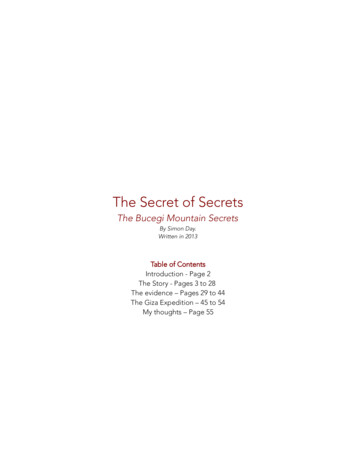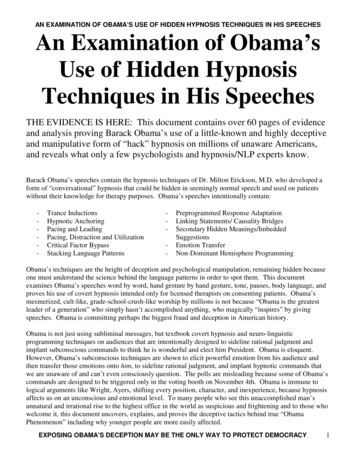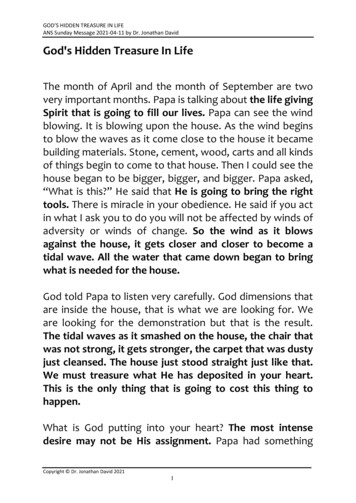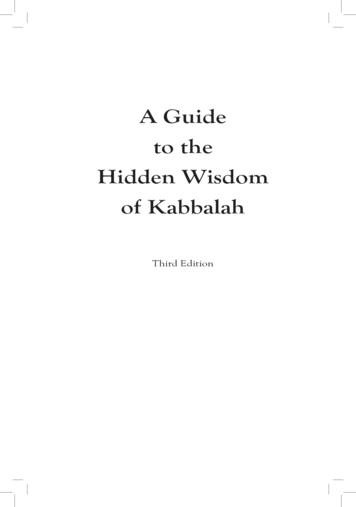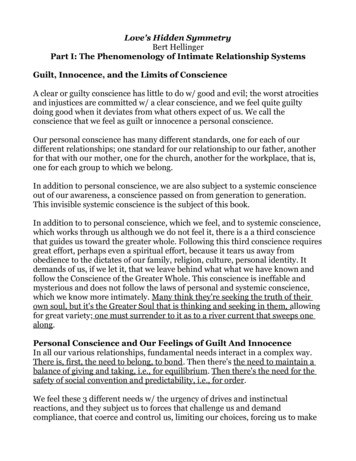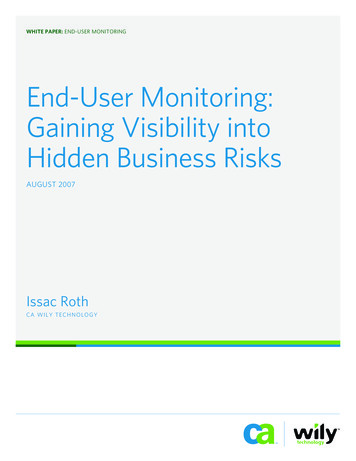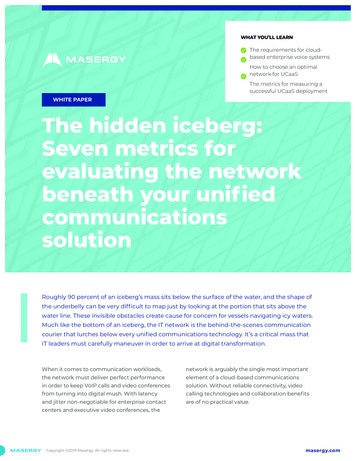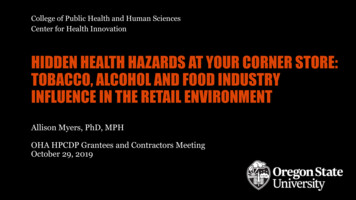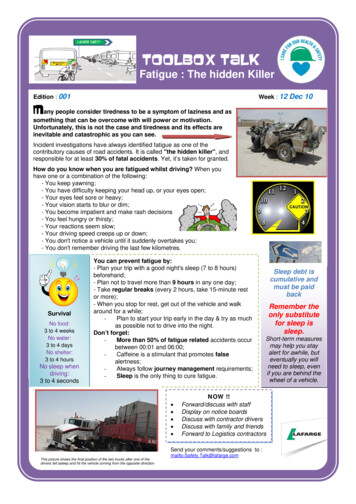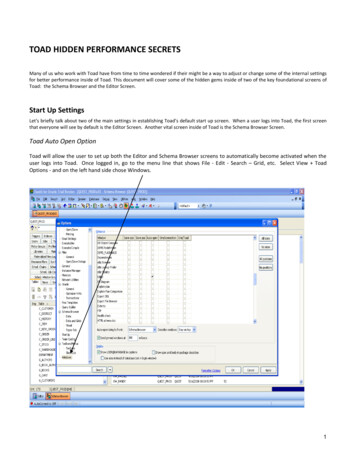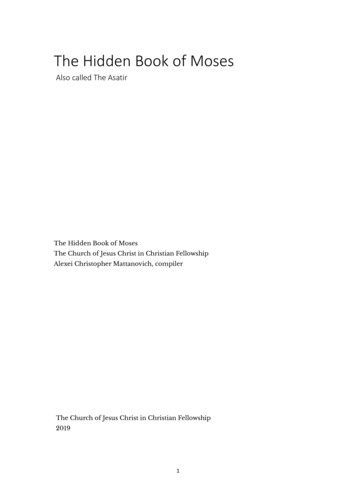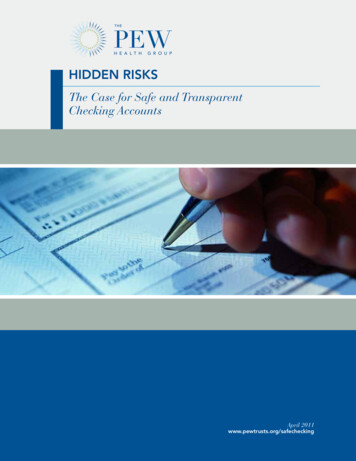
Transcription
H E A L T HG R O U PH E A L T HG R O U PHidden RisksH E A L T HG R O U PThe Case for Safe and TransparentChecking AccountsH E A L T HH E A L T HG R O U PH E A L T HH E A L T HG R O U PG R O U PG R O U PH E A L T HG R O U PFebruaryApril g
Hidden Risks: The Case for Safe and Transparent Checking AccountsTable of Contents1 Executive Summary4 Introduction6 I. Disclosure11 II. Overdraft Options12 III. Overdraft Fees14 IV. Processing of Deposits and Withdrawals18 V. Dispute Resolution19 VI. The Cost of a Checking Account22policy Recommendations23 Appendix A: Explication of Table 4—Median Fees and Most CommonPolicies for Checking Accounts25 Appendix B: Methodology29 Endnoteswww.pewtrusts.org/safechecking
H E A L T HG R O U PHidden RisksThe Case for HSafeChecking AccountsE A LandT H TransparentG R O U PExecutive SummaryA checking account is the most basic and necessary financial product for American consumers.Nine out of 10 Americans have a checking account, making it the most widely utilized financialH E A L T H G R O U Pservices product in the United States. The federal government recognizes the importanceof checking and other deposit accounts by insuring deposits up to 250,000 per accountagainst the failure of the bank.1 Checking accounts provide a secure way for Americans tocollect earnings and make payments, and for many, they serve as the entry to the financialmainstream, where savings and credit products are available. As the vehicles for billions oftransactions each day, checking accounts are essential to the national economy.E A L T H G R O U PThis ubiquitousHproductis at the center of profound changes to our system of transacting.Paper checks are increasingly a thing of the past as Americans use debit cards to accesstheir checking accounts. The Check Clearing for the 21st Century Act of 2003 (Check 21 Act)allowed banks greater freedom to transmit funds electronically and reduced the paper trailprovided to consumers.2 Overdraft coverage programs once reserved for occasional use arenow widespread. These changes are little understood by consumers, and their impact hasbeen little studied. Scarce comprehensive data exist on the state of checking accounts intoday’s modern world.In October 2010, the Pew Health Group’s Safe Checking in the Electronic Age Project began astudy of checking account terms and conditions to examine both the state of the marketplaceand the effect of current regulations covering checking accounts. Pew analyzed more than 250types of checking accounts offered online by the 10 largest banks in the United States, whichhold nearly 60 percent of all deposit volume nationwide. In researching checking accounts, Pewcharted the median and the range for many fees; the variations in key practices; and the extentof certain practices, including some that are the subject of legal challenges (see Table 4).3Through this research, we identified five practices that put consumers at financial risk,potentially exposing them to high costs for little benefit.Pew’s findings are as follows: Banks do not provide important policies and fee information in a concise and easy-tounderstand format that allows customers to compare account terms and conditionsamong banks. Pew’s research showed that the median length of bank disclosures forkey checking account policies and fee information was 111 pages. In addition, the banksoften used different names for the same fee or service; put the information in differentdocuments, different media (Web or hard copy), or different locations in a document; anddid not summarize or collect key information anywhere. Accountholders are not provided full information about the respective costs of overdraftoptions. All 10 of the banks in the study, for at least some transactions, offered programs—“overdraft penalty plans”—in which the bank covers overdrafts for a set per-overdraft charge.Nine of the 10 banks also offered “overdraft transfer plans” in which the bank transfers fundsto cover overdrafts in a customer’s checking account from the customer’s savings account,www.pewtrusts.org/safechecking
Hidden Risks: The Case for Safe and Transparent Checking Accountscredit card, or line of credit. Customers can also choose not to enroll in any overdraft planto avoid these fees for ATM and point-of-sale (POS) debit card transactions. These planshave significantly different features and fees; however, banks are not required to provide fullinformation at the time of opt-in about all overdraft options available, including the price forlower-cost options. Bank overdraft penalty fees are disproportionate to the size of the median overdraftamount. Overdraft fees will cost American consumers an estimated 38 billion in 2011—anall-time high.4 The median overdraft amount is 36, yet the median overdraft penalty feeis 35. In addition, the majority of checking accounts charged an extended overdraft feeafter a median of seven days if the fees and principal were not paid. The median extendedoverdraft fee was 25. While banks have to incur a risk that they will not be repaid, mostinstitutions manage this by limiting the overdraft amount given to any customer.5 Banks havelong argued that overdraft penalty fees are not compensation for the cost of overdrafts to thebank but rather are designed to deter customers from repeating this behavior. Penalty fees inother consumer financial products (e.g., credit cards) are related in size to the violation. Banks reserve the right to reorder transactions in a manner that will maximizeoverdraft fees. Overdraft penalty fees are imposed each time a withdrawal is posted to anaccount with insufficient funds to cover it at that moment. Banks can maximize the numberof times an account “goes negative” by reordering deposits and withdrawals to reduce theaccount balance as quickly as possible. Posting withdrawals before deposits and postingwithdrawals from largest to smallest have the effect of maximizing overdrafts. Currently, nofederal regulation governs posting order.6 Only two banks in this study, representing 48percent of accounts, commit to posting deposits before withdrawals. The rest reserve theright to post withdrawals first. As of October 2010, when Pew collected its data, all banksstudied reserved the right to reorder transactions from highest to lowest amount. Sincethen, a limited number of banks have altered this policy and no longer post all withdrawalsfrom highest to lowest for all of their accounts. More than 80 percent of accounts examined contain either binding mandatoryarbitration agreements or fee-sharing provisions that require the accountholder to paythe bank’s losses, costs, and expenses in a legal dispute regardless of the outcomeof the case.7 Seventy-one percent of account agreements reviewed by Pew requireaccountholders to submit to the decision of a private arbitrator selected by the bank inthe case of a dispute. An additional 12 percent of checking account agreements in thisstudy provided that accountholders have the right to settle their claims in a court, but thecustomer is liable for the bank’s losses, costs, and expenses regardless of outcome. In theWall Street Reform and Consumer Protection Act of 2010, Congress required the newlycreated Consumer Financial Protection Bureau (CFPB) to look at mandatory arbitration incontracts for financial products and services and, based on the findings, authorized theCFPB to write new rules limiting these clauses.8Based on these findings, Pew recommends the following policy solutions to protectconsumers, promote a competitive marketplace, and foster a level playing field amongfinancial institutions: Policy makers should require depository institutions to provide information about checkingaccount terms, conditions, and fees in a concise, easy-to-read format, similar to theSchumer Box used for credit cards.9www.pewtrusts.org/safechecking2
Hidden Risks: The Case for Safe and Transparent Checking Accounts Policy makers should require depository institutions to provide accountholders with clear,comprehensive pricing information for all available overdraft options when a customer isconsidering opting in to a program so that the customer can make the best choice amongoverdraft options, including choosing not to opt in for any overdraft coverage. Policy makers should require overdraft penalty fees to be reasonable and proportional to thebank’s costs in providing the overdraft loan. Furthermore, we suggest that regulators monitoroverdraft transfer fees and impose similar reasonable and proportional requirements if itappears that they are becoming so disproportionate as to suggest that they have becomepenalty fees as well. Policy makers should require depository institutions to post deposits and withdrawals in afully disclosed, objective and neutral manner that does not maximize overdraft fees, suchas in chronological order. The Consumer Financial Protection Bureau, in its study of arbitration agreements, shouldexamine the prevalence of binding arbitration clauses; of fee shifting provisions; andof “loss, costs, and expenses” clauses in checking accounts and assess whether suchprovisions prevent consumers from obtaining relief.www.pewtrusts.org/safechecking3
Hidden Risks: The Case for Safe and Transparent Checking AccountsIntroductionA checking account is the financial cornerstone for the overwhelming majority of Americanfamilies—often the bank product that provides consumer entry into the financial mainstream.Nine in 10 adult Americans have a checking account, representing a significantly largerproportion of the population than those holding a mortgage or credit card.10 Millions ofconsumers use bank or credit union checking accounts every day to collect their earnings andpay their bills. The federal government, through the Federal Deposit Insurance Corporation(FDIC), encourages the use of checking accounts by providing a guarantee that the money inthem (up to 250,000 per account) is safe even if the bank fails.11 As a result of these factors,checking accounts have come to play a vital role in the American economy by facilitating thesafekeeping and transfer of funds for consumers and offering a gateway to savings and creditrequired for investments such as the purchase of homes and higher education. It is to thebenefit of banks and consumers, and the nation as a whole, that checking accounts be safeand user friendly.Yet checking accounts lack some important types of consumer protections compared to otherconsumer financial products. For example, credit cards have limitations on the dollar amountof late fees and over-the-limit fees.12 In addition, their applications must clearly and conciselydisclose key terms in what is known as a “Schumer Box” (see Figure 2).13 In contrast, checkingaccounts have neither limitations on fees nor any requirements that critical information bepresented in a consolidated format.Regulators are authorized by federal banking laws to reduce risks to consumers in checkingaccounts, but that authority has not been actively utilized.14 Checking accounts are subject todisclosure requirements under the Truth in Savings Act and the Electronic Fund Transfer Act.15However, Pew’s research shows that these requirements have not been effective in producingclear and useful information for consumers. In addition, the Electronic Fund Transfer Act and theUniform Commercial Code provide certain dispute rights to consumers.16 The Expedited FundsAvailability Act governs how long a bank may hold a deposit before posting it to a customer’schecking account.17 Despite substantial advances in technology that speed the processing of adeposit, the Board of Governors of the Federal Reserve (the Fed) has only recently proposedthe first update in over 20 years to the relevant regulations.18 Protections are also found in theFederal Trade Commission Act (FTCA), which defines “unfair or deceptive acts or practices”(UDAP) and allows certain banking regulators to ban such practices, yet no federal agency hasever applied these provisions to checking account practices.19Nine of the 10 banks in our study are currently supervised by the Office of the Comptroller ofthe Currency.20 The Fed, under the FTCA, has the authority to write UDAP regulations governingproviders of checking accounts and other consumer financial products.21 However, the DoddFrank Wall Street Reform and Consumer Protection Act of 2010 transfers rule-writing authorityand supervision for all 10 of the banks that Pew examined to the new Consumer FinancialProtection Bureau (CFPB), and its regulatory reach will include the power to ban those practicesthat are deemed to be “abusive” and “unfair or deceptive.”22 Beyond this broad authority, theCFPB is also authorized to write regulations to ensure that the features of any consumer financialproduct or service are fully, accurately, and effectively disclosed.23www.pewtrusts.org/safechecking4
Hidden Risks: The Case for Safe and Transparent Checking AccountsWhat Does “Abusive” 24 Mean?The Dodd-Frank Wall Street Reform and Consumer Protection Act of 2010 defines as“abusive” any act or practice that:“materially interferes with the ability of a consumer to understand a term or condition of aconsumer financial product or service; or takes unreasonable advantage ofa) a lack of understanding on the part of the consumer of the material risks, costs, orconditions of the product or service;b) the inability of the consumer to protect the interests of the consumer in selecting orusing a consumer financial product or service; orc) the reasonable reliance by the consumer on a covered person [a provider of aconsumer financial product or service] to act in the interests of the consumer.”In October 2010, the Pew Health Group’s Safe Checking in the Electronic Age Project began astudy of checking account terms and conditions to examine both the state of the marketplaceand the effect
of checking and other deposit accounts by insuring deposits up to 250,000 per account against the failure of the bank.1 Checking accounts provide a secure way for Americans to collect earnings and make payments, and for many, they serve as the entry to the financial mainstream, where savings and credit products are available. As the vehicles for billions of
